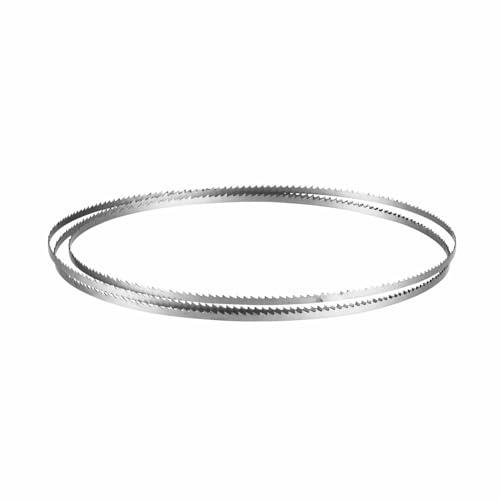While a band saw can be your best friend in woodworking, it’s only as good as the blade you’ve chosen. You’ll find dozens of options flooding the market, from premium stainless steel models to budget-friendly multipacks. Whether you’re working with hardwoods, softwoods, or both, selecting the right blade will determine if your cuts are smooth and precise or rough and wasteful. Let’s explore the top performers that’ll elevate your woodworking game.
Bosch BS62-6WA 62 in. 6 TPI General-Purpose Stationary Band Saw Blade
The Bosch BS62-6WA band saw blade proves ideal for woodworkers seeking both versatility and precision in their cuts. With its 6 TPI design and premium stainless steel construction, you’ll achieve clean cuts across various wood types. The blade’s advanced laser-cut technology guarantees exact specifications for consistent performance.
At 62 inches long and featuring optimized tooth geometry, this blade fits most standard stationary band saws. You’ll appreciate its durability and heat resistance during extended use. While it excels at wood cutting, you can also use it effectively on aluminum and plastics. The 4.3-star rating from users confirms its reliability for general-purpose applications.
Best For: Woodworking enthusiasts and DIY craftspeople who need a reliable, general-purpose band saw blade for making precise cuts in wood and occasional work with softer materials like aluminum and plastic.
Pros:
- Premium stainless steel construction with laser-cut precision for consistent, accurate cuts
- Versatile 6 TPI design works well for various wood types and some non-ferrous materials
- Compatible with most standard stationary band saws and offers good heat resistance
Cons:
- Not suitable for cutting steel or harder metals
- Some users report quality control issues
- Higher price point compared to generic alternatives
FOXBC Bandsaw Blades for Craftsman 12″ (2 Pack)
Designed for Craftsman 12″ band saws, FOXBC’s two-pack blade set offers a practical solution for woodworkers who need precision cutting in hardwoods, softwoods, and even non-ferrous metals.
Each blade measures 80 inches long, 1/4 inch wide, and features 14 TPI with hook teeth for detailed work. They’re crafted from high-grade carbon steel using specialized welding techniques for heat resistance. While some users report mixed experiences with durability, particularly when cutting spruce, replacement blades have shown improved performance. You’ll find these blades fit well on older Craftsman models, specifically the 137.224320, though cutting efficiency may vary based on your specific applications.
Best For: Hobbyist woodworkers and DIY enthusiasts with Craftsman 12″ band saws who need precision cutting for detailed work in various materials including hardwoods and non-ferrous metals.
Pros:
- Perfect fit for older Craftsman band saw models, especially 137.224320
- High-grade carbon steel construction with heat-resistant properties
- Versatile 14 TPI design suitable for multiple materials including hardwood and plastics
Cons:
- Inconsistent durability with some blades showing reduced efficiency after limited use
- Mixed performance when cutting soft woods like spruce
- Quality control issues reported with welding smoothness on some blades
POWERTEC Bandsaw Blades for Craftsman 12″ (2 Pack)
Craftsmen seeking reliable blades for their 12-inch Sears band saw will find an excellent match in POWERTEC’s 80-inch blade two-pack. These 1/8-inch wide blades feature 14 TPI and premium carbon steel construction, hardened to RC 64-66 for lasting performance.
You’ll appreciate the precision cuts these blades deliver across wood, plastic, and non-ferrous metals, thanks to their optimized tooth geometry and raker set design. They’re specifically engineered for Craftsman models 137.224320, 9HT2433N, and 9HT23331N. While thinner than 1/4-inch alternatives, they offer smooth cutting action and easy installation at a competitive price point.
Best For: Craftsman 12″ band saw owners who need precise, thin-kerf cutting capability for detailed woodworking and non-ferrous metal projects.
Pros:
- High-quality carbon steel construction with RC 64-66 hardness rating
- Perfect fit for specific Craftsman models with easy installation
- Optimized 14 TPI tooth geometry for smooth, precise cuts
Cons:
- Less durable than wider 1/4-inch blade options
- Limited to lighter-duty cutting applications due to thin blade width
- May require more frequent replacement with heavy use
POWERTEC 93-1/2 Inch Bandsaw Blades for Woodworking (3 Pack)
With versatility at its core, POWERTEC’s three-pack bandsaw blade assortment gives you everything needed for diverse woodworking projects. You’ll get three distinct blades: a 1/2-inch for general woodwork, a 1/8-inch for scroll cutting, and a 1/4-inch for wood cutting – all measuring 93-1/2 inches.
Made from premium carbon steel and hardened to RC 64-66, these blades fit popular brands like Delta, Grizzly, and Craftsman. Their ideal tooth geometry guarantees smooth cuts on hard and soft woods, plastics, and non-ferrous metals. While some users note sharpness could last longer, most praise the blades’ performance and value for furniture making and general woodworking tasks.
Best For: Woodworking enthusiasts and DIY craftsmen who need versatile blade options for various cutting tasks from general woodwork to detailed scroll cutting.
Pros:
- Versatile 3-blade assortment covers most woodworking needs
- Compatible with multiple popular bandsaw brands
- Premium carbon steel construction with optimal tooth geometry
Cons:
- Blade sharpness may not last as long as some users expect
- Higher price point compared to single-blade options
- 93-1/2 inch size limits compatibility to specific saw models
AYAO Pack of 2 Band Saw Blades 93-1/2 Inch X 1/4 Inch X 12TPI
The AYAO Pack of 2 Band Saw Blades delivers precise cuts for woodworkers seeking value without compromising quality. At 93-1/2 inches long and 1/4 inch wide, these 12 TPI blades fit numerous popular brands like Delta, Rockwell, and Jet.
You’ll appreciate the raker set teeth arrangement that provides smooth, straight cuts in materials under 1 inch thick. While they’ll handle 2-inch hardwood at a slower pace, the unique welding technique guarantees durability. They’re easy to install and perform well on both new and older bandsaws. At half the price of name-brand alternatives, these blades offer excellent value for your woodworking needs.
Best For: Woodworking hobbyists and DIY enthusiasts seeking affordable, reliable band saw blades for general-purpose cutting and materials under 1 inch thick.
Pros:
- Excellent value with two blades at half the price of name brands
- Compatible with multiple popular bandsaw brands and models
- Easy installation and smooth cutting performance on thin materials
Cons:
- Slower cutting speed when working with 2-inch hardwood
- Some reports of blade breakage during use
- May require frequent cleaning due to carbon buildup
Factors to Consider When Choosing Band Saw Blades for Wood
When selecting band saw blades for woodworking, you’ll need to match both the blade width and length to your specific saw model while considering the teeth per inch (TPI) count for your cutting needs. The blade’s material quality and construction will impact its durability and cutting performance, so it’s worth investing in well-made blades from reputable manufacturers. You should also factor in your required cutting speeds, as different blade types are optimized for various speeds and applications.
Blade Width and Length
Selecting appropriate blade width and length stands as one of the most essential decisions you’ll make when choosing a band saw blade for woodworking. Your band saw model will determine the required blade length, with common options including 62, 80, and 93.5 inches.
When it comes to blade width, you’ll need to match it to your intended cutting tasks. If you’re planning intricate cuts and curves, you’ll want to opt for narrower blades, particularly 1/8-inch ones that excel at scroll cutting. For general woodworking, a 1/4-inch blade offers excellent versatility. Wider blades work best for straight cuts and thicker materials. Remember that blade thickness affects both maneuverability and durability – thinner blades are easier to control but may not last as long as their thicker counterparts.
Teeth Per Inch (TPI)
Understanding Teeth Per Inch (TPI) ranks among three essential factors in choosing the right band saw blade for your woodworking projects. You’ll need to match your TPI to both your material and desired outcome. If you’re working with thick hardwoods or doing resawing work, opt for blades with 6-10 TPI for faster, more efficient cuts.
For detailed work on thinner materials like softwoods and plastics, you’ll want higher TPI blades (14-18) to achieve smoother finishes. If you’re looking for versatility, consider blades with 10-14 TPI, as they offer a good balance for general-purpose cutting. Remember, selecting the wrong TPI can damage your blade and compromise your work quality, so take time to evaluate your specific cutting needs before making your choice.
Material and Construction Quality
The materials and build quality of your band saw blade directly impact its performance and longevity. You’ll find that high-grade carbon steel and stainless steel blades offer superior heat resistance and durability, typically hardened to a Rockwell rating of 64-66 for lasting sharpness.
When selecting your blade, consider the thickness carefully. Thinner blades excel at intricate cuts and tight curves, while thicker ones handle tougher materials better. Pay attention to tooth design and arrangement – features like raker sets or hook teeth are engineered for specific cutting tasks. You’ll also want to examine the blade’s welding quality, as proper welding techniques guarantee structural integrity and smoother cutting action. Poor welding can lead to premature failure, so it’s worth investing in blades with quality construction.
Cutting Speed Requirements
Several essential factors determine ideal cutting speeds when choosing band saw blades for woodworking. You’ll need to match your blade’s TPI to your material thickness – use higher TPI blades (like 14 TPI) for thinner wood and finer cuts, while selecting lower TPI options (such as 6 TPI) for thick lumber and faster cutting.
When setting your cutting speed, you’ll want to maintain slower speeds for wood to prevent burning and achieve cleaner results. Your blade’s design plays a vital role too – wider blades work best for straight cuts at consistent speeds, while narrow blades excel at curved cuts. To maintain ideal cutting speeds throughout your project, choose high-grade carbon steel blades with proper heat resistance, as they’ll retain their performance longer and deliver more reliable results.
Compatible Saw Models
Matching your band saw blade to your specific model stands as a critical first step in achieving excellent cutting performance. You’ll need to verify the exact blade dimensions required for your saw, including length, width, and thickness specifications.
While many blades work across multiple brands like Delta, Rockwell, Jet, and Craftsman, you shouldn’t assume universal compatibility. Check your saw’s manual or manufacturer’s guidelines to confirm the proper blade specifications. Pay close attention to the required tooth configuration and TPI settings for your intended cutting tasks.
Don’t forget to review compatibility charts provided by blade manufacturers. They’ll help you select the right blade that matches both your saw’s requirements and your woodworking needs. Making sure these specifications align will guarantee peak cutting efficiency and results.







